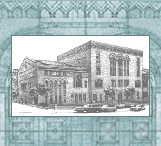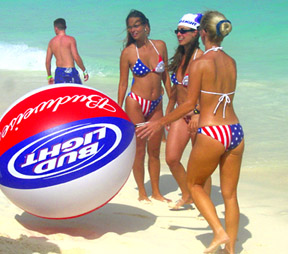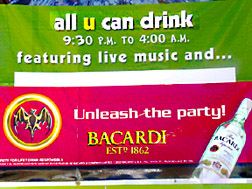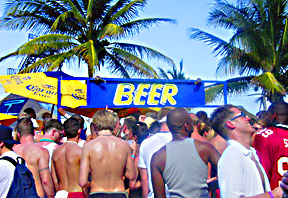

Our
mission is to reduce the number of injuries and deaths due to
injuries,
through prevention, improved trauma care, and improved rehabilitation.
Binge drinking, having 5 or more drinks in one sitting, is increasing in the US and the sharpest increase is occurring among underage drinkers, who cannot legally drink. Young drinkers between the ages of 18 and 20 had the highest rate of binge-drinking episodes (15.3 episodes per person per year). The rate of binge drinking among these young people increased 56% over the course of the study (1993-2001).
[Naimi, T, et al. Binge drinking among US adults. JAMA, January 1, 2003)
March 6, 2003
.

Spring Break--Awash in the Alcohol Industry's Tsunami of Booze
Spring is just around the corner, and once again thousands of underage American students will head to various
American and International hot spots for a "break" which will likely entail soaking up the sun and lots of booze. 
Spring Break madness is fueled by the alcohol industry's enormous presence at
hot spots like Cancun, which has become one of the most popular spring break destinations, with some 170,000 American students visiting during the 8
weeks prior to Easter. In addition to the alcohol industry's profiteering from Spring Break, the travel industry
has also stepped in to reap their share of the wealth made from sending underage students on a Spring Break that is one big
drinking binge.
Some travel agencies have created travel packages promoting sun, fun, surf, and sex,
in addition to selling the idea that underage Americans can drink and use drugs and go
unharassed in foreign
countries. One travel web site proudly proclaims, "Your yearly intake [of alcohol] could happen in one small week in
Cancun." As USA Today reported recently, "Tour packages that combine airfare, lodging, meals and unlimited alcohol in
nightclubs represent a travel "experience" for students, several tour operators say."
("Alcohol-Soaked Spring Break Lures Students Abroad" USA Today
1/5/2003) However, health officials have begun to look at what happens to
American students in Mexico on Spring Break and have found that the experience sometimes
includes injuries, deaths, rapes, and stays in Mexican jails.
One study of the drinking patterns of students on Spring Break found that:
The average man reported drinking 18 drinks per day ; The average woman reported drinking 10 drinks per day
(May 1998 Journal of American College Health.) Of the 442 women and 341 men that were surveyed, more than 50 percent of all men and more than
40 percent of all women drank until they became sick or passed out at least once. 40% of the men and 33% or the women reported being drunk daily. (Smeaton)
In addition, another study of college drinkers on campus found that among frequent binge drinkers (those men
who consume more than 5 drinks and women who consume more than 4): 
49.7% engaged in unplanned sex
52.3% engaged in unprotected sex
58.4% had trouble with the police
58.9% were injured.
(Weschsler, Henry. et al College Alcohol Use: a Full or Empty Glass? J of Amer Coll Health v.47 n6 (May
1999):247)
Spring Break is just the apex of an ever present problem: the alcohol industry's
targeting of young people.
Young people ages 12-20 saw more television ads for beer and ale in 2001 than for fruit juices and fruit-flavored
drinks; gum; skin care products; cookies and
crackers; chips, nuts, popcorn and pretzels; sneakers; non-carbonated soft drinks; or sportswear jeans. (
Center on Alcohol Marketing and Youth. (December 2002). Television: Alcohol's Vast Adland:
3.)
A study of 12 year-olds found that children who were more aware of beer advertising held more favorable views on
drinking and expressed an intention to drink more often as adults than did children who were less knowledgeable about the ads. (
Grube, J.W. (1995). “Television alcohol portrayals, alcohol advertising and alcohol expectancies among children and adolescents.” Effects of
the Mass Media on the Use and Abuse of Alcohol. S.E. Martin and P. Mail. Bethesda: National Institute on Alcohol Abuse and Alcoholism, 105-121.)
$1.57 billion was spent on alcohol advertising in measured media (television, radio, print, and outdoor advertising) in
2001.9 The FTC estimated in 1999 that the
alcohol industry may spend two to three times this amount each year to promote their products, through sponsorship,
internet advertising, point-of-sale materials,
product placement, brand-logoed items, and other means. This would mean that the alcohol industry spent at least
$3 billion on advertising and promotion in
2001. (Federal Trade Commission. (September 1999). Self-Regulation in the Alcohol Industry: A Review of Industry
Efforts to Avoid Promoting Alcohol to
Underage Consumers: Appendix B: i-ii.) 
The industry's efforts to target young people are so successful that underage young people are drinking excessively
and experiencing serious consequences as a result:
One study which examines drug and alcohol treatment admissions, shows that young underage drinkers account for substantial
numbers of admissions for primary alcohol abuse. Young people under age 21 accounted for 14% of admissions for alcohol with a secondary drug
problem (approx. 45,000 in 1999) and 6% of alcohol-only admissions (approx 26,000 in 1999) .
SAMHSA. The DASIS Report. February 22, 2002.
http://www.samhsa.gov/oas/facts.cfm
What Can Be Done?
-
Some universities have decided to step in and address the problem of alcohol on campuses and the promotion of Spring Break drinking vacations by creating alternative Spring Break projects. The University of Southern California is
promoting projects which enable students to do community service, learn about the environment or a different culture. Last year Alternative Spring Break destinations included: a Navajo Nation trip, an environmentally focused trip to Death Valley, and helping the homeless in Monterey. ("Volunteer Center Provides Three Spring Break Alternatives
See below for other alternative spring break adventures: -
States can hold the industry responsible and require the industry to share the burden of costs of alcohol-related problems. The states can propose legislation like CA Assemblywoman Wilma Chan's (AB 216) which imposes a fee on the producers of beer and distilled spirits based on their share of the underage consumer market, the revenues from which will be used to create youth alcohol prevention and recovery centers throughout the state in order to help young people stay healthy and alcohol-free.
-
The Federal Trade Commission should reopen its inquiry into the industry's ability to self-regulate its advertising and marketing practices. In several reports, The Center on Alcohol Marketing and Youth at Georgetown University, has illustrated how far short the industry's efforts to reduce the targeting of young people via advertising fall. You can learn more by reading OverExposed: Youth a Target of Alcohol Advertising in Magazines and Drops in the Bucket: Alcohol Industry "Responsibility" Advertising on Television in 2001. The alcohol industry cannot be allowed to continue targeting young people and promoting illegal and excessive alcohol consumption.
To find out More:
Center on Alcohol Marketing and Youth
www.camy.org
Center for Science in the Public Interest: Booze News
www.cspinet.org/booze/index.html
National Center on Addiction and Substance Abuse at Columbia University
www.casacolumbia.org/
National Clearinghouse for Alcohol and Drug Abuse Information
www.health.org/
National Institute on Alcohol Abuse and Alcoholism
www.niaaa.nih.gov/
Volunteer Center provides three Spring Break alternatives
www.usc.edu/student-affairs/dt/V136/N15/03-volun.15c.html
Outdoor Persuits provides spring break alternatives (The Post, Ohio Univ)
http://thepost.baker.ohiou.edu/archives3/mar02/030702/t3.html
Collection of Spring Break Alternatives
www.uiuc.edu/ro/asb/news.htm
Students experience spring break in unusual way
www.kstatecollegian.com/issues/v099b/sp/n126/cam-SB-alternative-gillila.html
Spring Break Alternatives Less Crowded and Personal Growth Opportunities (Road to Adventures)
www.roadtoadventures.com/misc-articles/sprbk11-02.htm
 |
 |
|---|